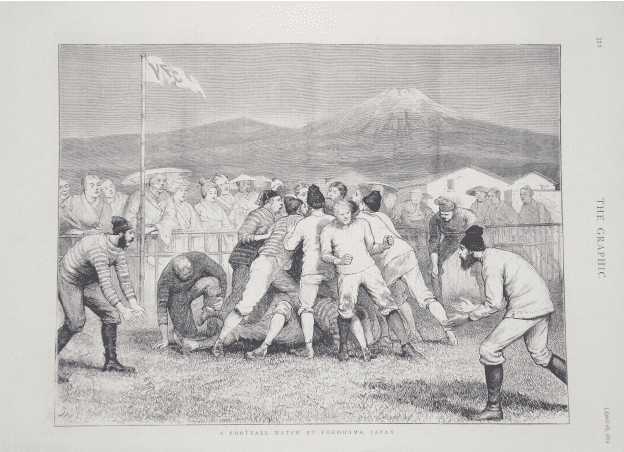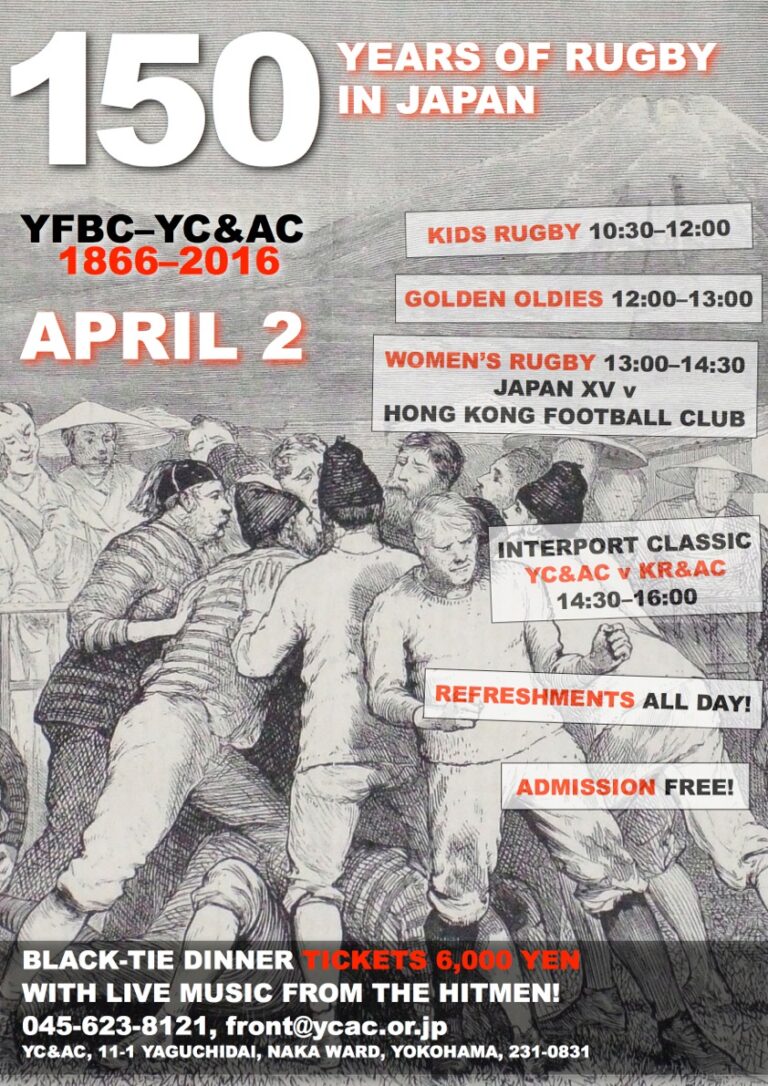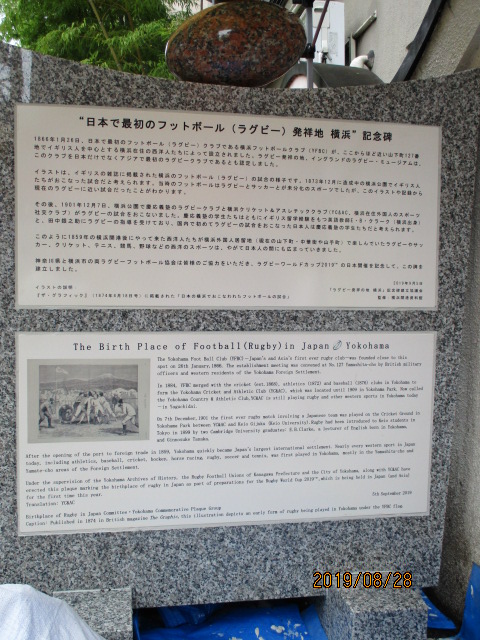MARLBOROUGH COLLEGE’S UNKNOWN REMARKABLE CONTRIBUTIONS TO 19th CENTURY JAPAN ESPECIALLY IN FIELD OF RUGBY AND OTHER SPORTS
SCHOOL’S ALUMNI HELPED INTRODUCE MANY SPORTS IN JAPAN, INCLUDING RUGBY, INITIATED FOUNDING OF KEY YOKOHAMA & KOBE SPORTS CLUBS, & EVEN HELPED WRITE JAPAN’S CONSTITUTION
Marlborough College is justly proud of its rugby history and pedigree in the UK. The school played the first inter-school game in 1864 when it played a match against Clifton College and in January 1871 the Marlborough Nomads, founded by and mainly consisting of the school’s old boys, was one of only 21 clubs that met in London and formed the Rugby Football Union. In the same year in the first international rugby match – between England and Scotland – Alfred Hammersley represented (and later captained) England. In the next year’s game two more Nomads played for England alongside Hammersley. The following year Hammersley captained England which selected two other Nomads while a fourth played for Scotland. A rather young F. I. Currey, capped in 1872, became secretary of the RFU in 1874, and president between 1884 and 1886.
But it was not only on playing fields of Victorian England that a handful of young alumni of Marlborough College were prominent in the development of rugby.
Remarkably, even before the Nomads were founded and before that first inter-school game was played, on the other side of the world in a country ruled by a Shogun, protected by samurai warriors, one and probably two young alumni, Harry Rawson and William Henry Smith, were involved in the first recorded playing of rugby in Japan.
Harry Holdsworth Rawson (1843-1910) was born the year the school opened and entered it in Feb. 1854 but left when only 12 at Xmas 1855 and joined the Royal Navy. He fought in the Opium Wars in China before spending time in Japanese waters. He was a keen football player and cricketer and was still only 19 when he played in Japan’s first ever cricket match in June 1863, probably the only match in history where many of the players including at least one wicket keeper carried guns as they played – because they feared attack by samurai swordsmen. He became an Admiral and then Governor General of New South Wales where in 1906 one newspaper reported the Governor “recalled the first cricket match played in Japan between the Navy and a Shore team in 1863, a remarkable feature of which was the fact that half the players were playing football.” This is the first evidence of football being played in Japan. Rawson may well have provided the ball and may have played also while spending the new year of 1861 in Yokohama.

William Henry Smith (1838-1884?) stay in the school would have overlapped with Rawson because he left the school at Easter 1855 after almost four years there to join the Royal Marine Light Infantry (RMLI) and quickly made a name for himself first in the war in China and then in Mexico. Growing disturbances in Japan led to Lieut. Smith being dispatched to Yokohama as the head of the Legation Guard. Although he was officially assigned to a ship, he played for the Shore team in that first cricket match in Yokohama in 1863 and no doubt would have played football that day. As Yokohama slowly became a safe place again, he was able to take the initiative in creating many of Yokohama’s leading institutions including the Yokohama United Club, the Grand Hotel, and Japan’s first public garden. On January 26 1866 he is documented as proposing the first motion in the meeting in the bungalow of the Racquet Club (which he also created) that established the Yokohama Foot Ball Club, the first football club not only in Japan but also in Asia.
I hope you will agree that the achievements during Japan’s Edo period by these first two pioneering Marlborough OB’s are pretty impressive. But this is only the beginning of the contribution of the school’s alumni to the development of western sports, etc. in 19th century Japan.
The next young alumnus to impress was Arthur Hesketh Groom (1846-1918) who entered the school in 1861 leaving in summer of 1864. In 1869 Kobe, now the port for Osaka, was opened up to foreigners and Groom was one of the first adventurers to move to the new settlement. Late in the same year he played in the first cricket match played in Kobe and soon after took the lead in founding the Kobe Cricket Club. The following year he was one of the founders of the Kobe Regatta and Athletic Club (KRAC) which is still Kobe’s premier multi-sports club today. Groom is most famous for being the founder of Japan’s first golf club in Kobe and he is honored with a statue in that city.

In several ways the next gentleman was the most outstanding of all the school’s Victorian alumni who boldly ventured to Japan: Edgar Abbott (1849-1890) Abbott attended the school while Groom was there but left in the summer of 1862 after only one year because of the bankruptcy of his father who, like his grandfather, owned a famous London brewery. He arrived in Japan in 1869 and in 1870 a local newspaper praised his bowling in a cricket match. He was also a batsman and scored the highest score (146) ever on the club ground and as well as captaining the YC&AC cricket team in the first Interport cricket match against Kobe in 1888..
In 1873 Abbott participated in one of Japan’s first athletics meetings and with almost no practice astonished everyone by winning the 100 yards, in 11 seconds, and the 150 yards in 16.25 seconds. A list of athletics records published in 1904 shows him still holding the records for 100 yards (10.5 seconds ran in 1884) and 150 yards with that run in 1873. He was thus likely the fastest man in Japan in the 19th century. Being small, he was a natural half back on the football field and appears to have been the best player in Japan. One goal he scored in 1873 was described in a local newspaper and provides the best evidence as to the type of football being played by the club in Yokohama: “Abbott having caught the ball made a good run through his opponents and, with a fine drop kick, scored a goal for the Settlement.” Other clear evidence is a full-page illustration called “Football in Yokohama in both the Graphic of London and the US’ Harper’s Weekly which almost certainly shows Abbott as the central figure playing half back. Horseracing was the most popular sport in those days and Abbott was
much to the fore there too with his most publicized win being the Ladies Purse at the Yokohama Races in 1877. It is not surprising that the founder of the present YC&AC, J. P. Mollison, stated that Abbott was “one of the best all-round men, if not the very best, that ever came from England to the Far East.”
Abbott should be remembered most, however, for his two major achievements as an organizer:
- He was the real creator of the YC&AC in Yokohama, which is still Japan’s premier club for western sports, by initiating and leading the initiative in 1884 to merge the cricket, football, athletic and baseball clubs.
- He was the man behind the creation of what is now the brewery Kirin and, indeed, the name Kirin for its beer and the Kirin logo were both adopted shortly before he died suddenly in 1890 at 39.
One might think it would be hard to better the above achievements……. but in terms of awards received from the Emperor and impact on Japan, this alumnus beat all the above hands down: William Montaque Hammett Kirkwood (1850-1926)
Kirkwood attended the school from Oct. 1864 until Xmas 1867 gaining the Old Malburian scholarship and is the only one of these alumni to play in the school cricket XI (in 1867). He was called to the Bar by the Inner Temple in 1873 and arrived in Japan in 1874 and began working as a barrister and playing cricket. As early as 1878 he was already secretary and treasurer of the Yokohama Cricket Club. From 1882 to 1885 Kirkwood served as Crown Advocate in the court of Yokohama, and then also became a legal advisor to the Japanese government during which time he helped to write the Japanese constitution as well as getting involved in the occupation of Formosa.
For his services to Japan, the Meiji Emperor presented Kirkwood with Order of the Sacred Treasure (Second Class), the Order of the Rising Sun (Third Class), the Japanese Constitution Medal and the Silver Wedding Medal.
Two sports we haven’t mentioned the impact of a school alumnus on so fare are rowing and sailing. Step up Henry Charles Litchfield (1843-1907) who was also born in the year the school opened! Litchfield studied at Marlborough from August 1852 until the summer of 1860, overlapping with Rawson and Smith above and preceded Kirkwood to the Inner Temple. He first appears in sport reports in Japan when he won the double skulls race in May 1877. He captained the Yokohama Amateur Rowing Club for many years and organized the regattas. The enthusiasm for sailing as a part of these regattas had gone up and down over the years but Litchfield is widely credited with starting the explosion of interest in yachting after he arranged a sailing race in the 1886 regatta. In a few years yacht racing became perhaps the second most popular sport in Yokohama after horseracing.
There was one other talented alumnus who deserves recognition for his remarkable connection with Japan if only for the uniqueness and tragedy of his short links with the country: Walter Even Townsend (1879-1900)
The most remarkable thing about Townsend and Japan is that in his short life he spent not much more than one year in Japan, if that, but was born and died there. His English father, a banker, was transferred to New York in 1880 but Walter was still sent to Marlborough between Jan 1892 and the summer of 1896. In the spring of 1899 he realized his dream to enter the China Consular Service and was dispatched to be a student interpreter in Pekin, stopping off on the way very briefly in Yokohama and Kobe. Unfortunately, he arrived in Pekin just before the Boxer Uprising. Townsend was one of the heroes of the defence of the Legation when it was attacked but suffered two bullet wounds. He almost recovered, but it was decided to evacuate him to Yokohama, Tragically, within two days of arriving back in Japan he caught typhoid and died.
Thousands of young Englishmen went out to Japan after that country was opened up to foreign businesses in 1859 with many of them arriving not long after leaving school. Is it simply coincidental that alumni from Marlborough were instrumental in the introduction and development of nearly every western sport in Japan? Was it something to do with the way the school educated its pupils in sports or was it just that the above individuals just happened to be extraordinary individuals? Or was it that word was passed around the school about the attractiveness of life and sporting life in Japan and the opportunities the country offered?
Footnote on indirect historical links between Japanese rugby and Marlborough College’s most famous rugby son:
Alfred St. George Hamersley (1848 –1929) was one of the first England internationals and England captains. Hamersley must have been at Marlborough when several of the figures mentioned above were at the school. After leaving school, he became a barrister, as did Kirkwood and Litchfield mentioned above.
But the most interesting link is that Japan’s first international rugby matches involved nominally Canada but were in fact against players and teams in British Columbia because that was the main center of rugby in Canada at the time. How did it happen that remote British Columbia became a such an early powerhouse of Canadian rugby? In 1888, Alfred Hamersley, after living in New Zealand and playing a major role in introducing rugby in the South Canterbury area, moved to Vancouver where it is said he was the town’s first solicitor. He did not start the Vancouver Football Club but quickly got involved in the club. A year later the British Columbia Rugby Union (BCRU) was created with Hamersley as its first president.
Hamersley was likely still alive when BCRU started to make connections with Japanese rugby that led to the first Japanese international rugby matches being played in British Columbia in 1930, the year after Hamersley died. Two years later a Canadian representative team mainly consisting of players from BC toured Japan.

© Mike Galbraith 2016





